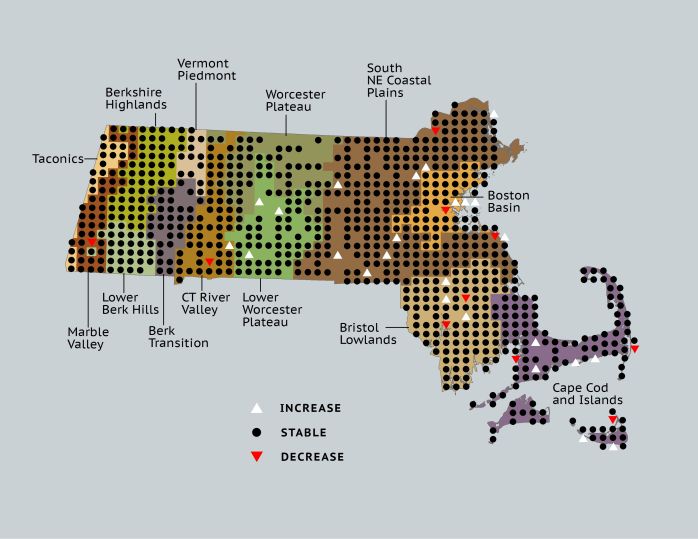Breeding Bird Atlases (BBA)
Find a Bird
Common Yellowthroat
Geothlypis trichas

Nearly ubiquitous and stable
Action/monitoring needed
“He has a cheery song of which he is not a bit ashamed, and when one happens to be near the particular thicket a pair of yellow-throats have chosen for their own, one has not long to wait for vocal proof that the male, at least, is at home.” – Henry W. Henshaw, Friends of Our Forests
The Common Yellowthroat is true to all parts of its name, breeding abundantly across much of North America and impressing birders with its buttery yellow throat. There are few locations in Massachusetts where Common Yellowthroats cannot be found breeding during the summer months. For many years, this species has been associated with wetlands and early-successional habitat. While such habitats are imperiled in many places in the Commonwealth, yellowthroats continue to breed across Massachusetts, signaling their ability to use other habitats as well. However, subtle signals of decline indicate that this species may not always be as widespread as it is today.
Historic Status
The Maryland Yellowthroat and the interesting sobriquet “Black-masked Ground Warbler” were both names for our most widespread warbler. Evidence suggests it was likely as ubiquitous in Massachusetts in the 1830s as it is today. The species, said William Peabody, “is one of our most common birds, found among the alders of almost every brook, from the beginning of May till the leaves fall,” (Peabody 1839). Nearly a century later, the story had not changed. “To make his acquaintance one has only to visit his favorite haunts,” wrote Edward Howe Forbush, “when presto! Up bobs that masquerading scrap of animated feathers, nervously voicing his alarm with a variety of scolding chirps and chattering notes” (Forbush 1929). By all accounts, the population remained strong for the next forty years, until the time when the fieldwork was undertaken for Atlas 1.
Atlas 1 Distribution
Rare indeed was the weedy ditch or damp forest edge that did not host a pair of Common Yellowthroats in Atlas 1, and the “Black-masked Ground Warbler” was found in 92% of the blocks surveyed. Common Yellowthroats were not missing from more than 3 or 4 blocks in any ecoregion west of the Connecticut River Valley. The Lower Worcester Plateau had some gaps, lacking Common Yellowthroats in roughly a dozen blocks. Some parts of the Coastal Plains and the heavily urbanized core of the Boston Basin also failed to support breeding yellowthroats, but these were exceptions to a rule of ubiquity. They were also widespread throughout the Bristol/Narragansett Lowlands and Cape Cod and the Islands.
Atlas 2 Distribution and Change
Atlas 2 continued to show the Common Yellowthroat persisting in all corners of the state, pressing their way into 97% of the blocks surveyed in the Commonwealth. They ranked as the number 4 most broadly distributed breeding bird. Overall they had stable or increasing block occupancy in every region of the Commonwealth, with the exception of the Marble Valleys, in which they only disappeared from a single block. The increases were similarly small, which is all that can happen to a species that is already near saturation.
Atlas 1 Map

Atlas 2 Map

Atlas Change Map

Ecoregion Data
Atlas 1 | Atlas 2 | Change | ||||||
Ecoregion | # Blocks | % Blocks | % of Range | # Blocks | % Blocks | % of Range | Change in # Blocks | Change in % Blocks |
Taconic Mountains | 16 | 100.0 | 1.8 | 24 | 96.0 | 2.4 | 0 | 0.0 |
Marble Valleys/Housatonic Valley | 39 | 100.0 | 4.4 | 38 | 97.4 | 3.8 | -1 | -2.6 |
Berkshire Highlands | 54 | 98.2 | 6.0 | 55 | 100.0 | 5.5 | 0 | 0.0 |
Lower Berkshire Hills | 28 | 100.0 | 3.1 | 30 | 96.8 | 3.0 | 0 | 0.0 |
Vermont Piedmont | 16 | 94.1 | 1.8 | 17 | 100.0 | 1.7 | 0 | 0.0 |
Berkshire Transition | 36 | 94.7 | 4.0 | 40 | 100.0 | 4.0 | 0 | 0.0 |
Connecticut River Valley | 53 | 94.6 | 5.9 | 64 | 98.5 | 6.3 | 0 | 0.0 |
Worcester Plateau | 73 | 93.6 | 8.2 | 88 | 100.0 | 8.7 | 0 | 0.0 |
Lower Worcester Plateau | 61 | 82.4 | 6.8 | 80 | 100.0 | 7.9 | 3 | 5.6 |
S. New England Coastal Plains and Hills | 247 | 91.5 | 27.6 | 277 | 97.9 | 27.5 | 7 | 3.1 |
Boston Basin | 49 | 87.5 | 5.5 | 52 | 92.9 | 5.2 | 2 | 3.6 |
Bristol and Narragansett Lowlands | 101 | 95.3 | 11.3 | 107 | 93.9 | 10.6 | 1 | 1.0 |
Cape Cod and Islands | 121 | 89.0 | 13.5 | 136 | 94.4 | 13.5 | 3 | 2.5 |
Statewide Total | 894 | 92.3 | 100.0 | 1008 | 97.2 | 100.0 | 15 | 1.8 |
Notes
Despite this apparent stability, the Breeding Bird Survey (BBS) shows significant declines in Common Yellowthroat abundance for Massachusetts, the New England/Mid-Atlantic Region, and the Eastern US overall. They fall into our “whispering bird” category – those species with a demonstrated stable or increasing breeding footprint from Atlas 2 data, but also a demonstrated decline in abundance from the BBS. This drives our final assessment that this is a species with a need for further monitoring and conservation action.



